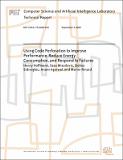Using Code Perforation to Improve Performance, Reduce Energy Consumption, and Respond to Failures
Author(s)
Hoffmann, Henry; Misailovic, Sasa; Sidiroglou, Stelios; Agarwal, Anant; Rinard, Martin
DownloadMIT-CSAIL-TR-2009-042.pdf (1.394Mb)
Additional downloads
Other Contributors
Computer Architecture
Advisor
Martin Rinard
Metadata
Show full item recordAbstract
Many modern computations (such as video and audio encoders, Monte Carlo simulations, and machine learning algorithms) are designed to trade off accuracy in return for increased performance. To date, such computations typically use ad-hoc, domain-specific techniques developed specifically for the computation at hand. We present a new general technique, code perforation, for automatically augmenting existing computations with the capability of trading off accuracy in return for performance. In contrast to existing approaches, which typically require the manual development of new algorithms, our implemented SpeedPress compiler can automatically apply code perforation to existing computations with no developer intervention whatsoever. The result is a transformed computation that can respond almost immediately to a range of increased performancedemands while keeping any resulting output distortion within acceptable user-defined bounds. We have used SpeedPress to automatically apply code perforation to applications from the PARSEC benchmark suite. The results show that the transformed applications can run as much as two to three times faster than the original applications while distorting the output by less than 10%. Because the transformed applications can operate successfully at many points in the performance/accuracy tradeoff space, they can (dynamically and on demand) navigate the tradeoff space to either maximize performance subject to a given accuracy constraint, or maximize accuracy subject to a given performance constraint. We also demonstrate the SpeedGuard runtime system which uses code perforation to enable applications to automatically adapt to challenging execution environments such as multicore machines that suffer core failures or machines that dynamically adjust the clock speed to reduce power consumption or to protect the machine from overheating.
Date issued
2009-09-03Series/Report no.
MIT-CSAIL-TR-2009-042